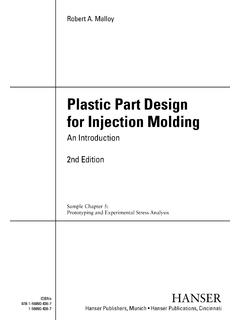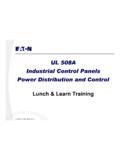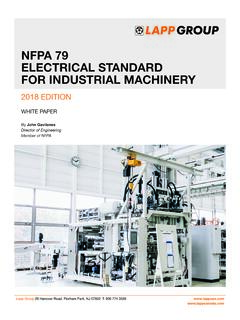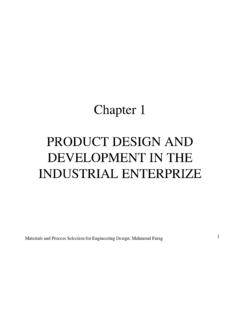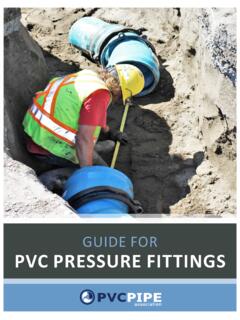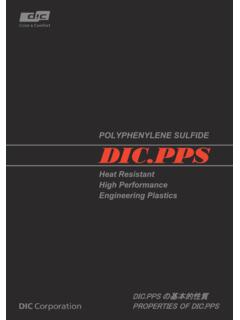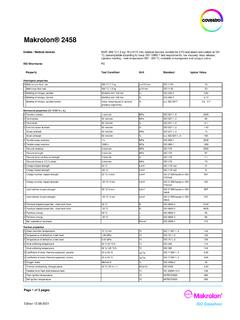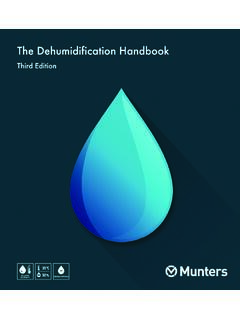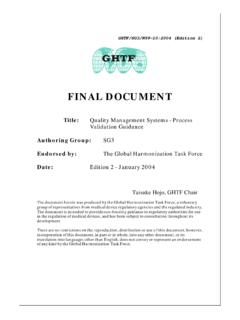Transcription of MATERIALS AND PROCESS IN MANUFACTURING Ninth Edition
1 Solutions Manual to Accompany MATERIALS AND PROCESS IN MANUFACTURING Ninth Edition E. Paul DeGarmo J T. Black Ronald A. Kohser Solutions Manual by Barney E. Klamecki Copyright 2003 John Wiley & Sons, Inc Contents Preface Page 1 Chapter 1 Introduction to MATERIALS and Processes in MANUFACTURING Page 3 Chapter 2 Properties of MATERIALS Page 10 Chapter 3 Nature of Metals and Alloys Page 20 Chapter 4 Equilibrium Phase Diagrams and the Iron-Carbon System Page 26 Chapter 5 Heat Treatment Page 34 Chapter 6 Ferrous Metals and Alloys Page 42 Chapter 7 Nonferrous Metals and Alloys Page 49 Chapter 8 Nonmetallic MATERIALS .
2 Plastics, Elastomers, Ceramics, and Composites Page 54 Chapter 9 Material Selection Page 63 Chapter 10 Measurement and Inspection Page 72 Chapter 11 Nondestructive Inspection and Testing Page 82 Chapter 12 PROCESS Capability and Quality Control Page 92 Chapter 13 Fundamentals of Casting Page 107 Chapter 14 Expendable-Mold Casting Processes Page 116 Chapter 15 Multiple-Use-Mold Casting Processes Page 124 Chapter 16 Powder Metallurgy Page 131 Chapter 17 Fundamentals of Metal Forming Page 140 Chapter 18 Hot-Working Page 150 Chapter 19 Cold-Working Processes Page 159 Chapter 20
3 Fabrication of Plastics, Ceramics, and Composites Page 173 Chapter 21 Fundamentals of Machining / Orthogonal Machining Page 182 Chapter 22 Cutting Tools for Machining Page 194 Chapter 23 Turning and Boring and Related processes Page 208 Chapter 24 Drilling and Related Hole Making Processes Page 217 Chapter 25 Milling Page 223 Chapter 26 Shaping, Planing, Broaching, Sawing, and Filing Page 229 Chapter 27 Abrasive Machining Processes Page 237 Chapter 28 Nontraditional Machining Page 242 Chapter 29 Workholding Devices Page 247 Chapter 30 Thread and Gear MANUFACTURING Page 252 Chapter 31 Surface Treatments, Finishing.
4 And Integrity Page 259 Chapter 32 MANUFACTURING Automation Page 267 Chapter 33 Rapid Prototyping and Freeform Fabrication Page 283 Chapter 34 Microelectronic MANUFACTURING and Electronic Assembly Page 291 Chapter 35 Fundamentals of Joining Page 303 Chapter 36 Gas Flame Processes Page 308 Chapter 37 Arc processes Page 310 Chapter 38 Resistance Welding and Other Welding Processes Page 316 Chapter 39 Brazing and Soldering Page 323 Chapter 40 Adhesive Bonding and Mechanical Fastening Page 327 Chapter 41 MANUFACTURING and Production Systems Page 333 Chapter 42 System and Cell Design Page 341 Chapter 43 Implementation of Lean MANUFACTURING Systems and Cells Page 349 1 Preface This version of the textbook contains significant new content and, so then, does the Solution Manual.
5 These notes are provided to explain some aspects of the new content. The authors of the textbook prepared the new content for the book, including all new questions and problems. I prepared only the answers to the new questions and solutions for the new problems. Many of the questions are broad, open-ended and raise real, practical concerns. The answers that I have prepared are intended to directly address the important concepts raised and provide some of the thought PROCESS leading to the answers. Where example applications of the concepts are provided these are intended to be starting points for consideration and discussion, not final, definite or unique answers.
6 Some internet web sites are suggested as example sites containing useful information. These are only suggestions as typical starting points for more in-depth investigation of the questions raised. I am always hesitant to refer to internet web sites since often the updating of them, and sometimes their continued existence, is problematic. Perhaps the best way to view the inclusion of a web site in the Solution Manual is as an indication of questions that are more open-ended and may require more material than is in the text for preparing answers. For the new quantitative problems and some of the problems from previous editions of the text I have used spreadsheets to produce solutions.
7 The intent is to provide the opportunity for users of the text to customize these problems. Problem variables and variable values can be changes with little effort. The difficulty is that to provide this capability specific software must be used since writing code that can be used on most computers is not warranted. Microsoft Excel 97 was used. In any case, the solutions are also provided in fixed form. Some question answers were put in the form of tables so that it is possible to slightly manipulate the questions. For example, various table cells can be cleared and fill-in-the-blank questions formulated.
8 Microsoft Word 97 was used for the Solution Manual text. Barney E. Klamecki March, 2003 2 3 CHAPTER 1 Introduction to MATERIALS and Processes in MANUFACTURING Review Questions 1. The availability and cost of manufactured products are an important part of our cost of living and the real wealth of the nation. Thus, reducing the cost of producer and consumer goods improves the productivity while holding down inflation, thereby improving the general standard of living. 2. This is true if you consider that everyone who used the output from a PROCESS , including all the intermediate steps, is a customer.
9 The operator of the next PROCESS is the user and customer of the proceeding PROCESS . In fact, some companies identify two customers, the external customer who buys the finished product and the internal customer, who builds the product one - , the people who work in the MANUFACTURING system. See Chapter 43 3. Job shop - an injection mold MANUFACTURING shop, the shop at a large university that produces research equipment and apparatus. Job shops are capable of producing products with great variety, typically employing highly skilled workers. Flow shop automobile assembly.
10 Flow shops are usually laid out so that specific products pass through a series of operations with no backflow. The product range is limited, production volume is large and labor skill is lower than in job shops. Project shop diesel-electric locomotive production facility. The end product is very large and so many machines, tools and people come to the product to produce it at a relatively fixed location. 4. In the context of MANUFACTURING , a MANUFACTURING system is a collection of men, machine tools, and material-moving systems, collected together to accomplish specific MANUFACTURING or fabrication sequences, resulting in components or end products.
